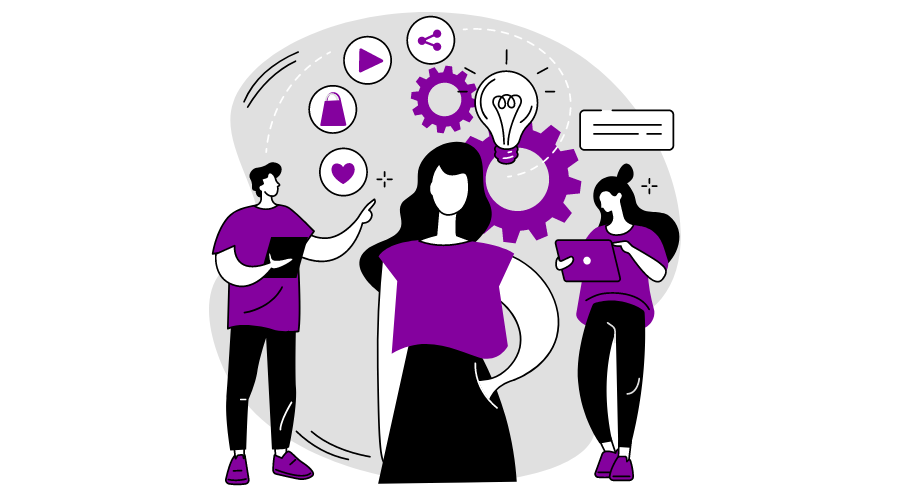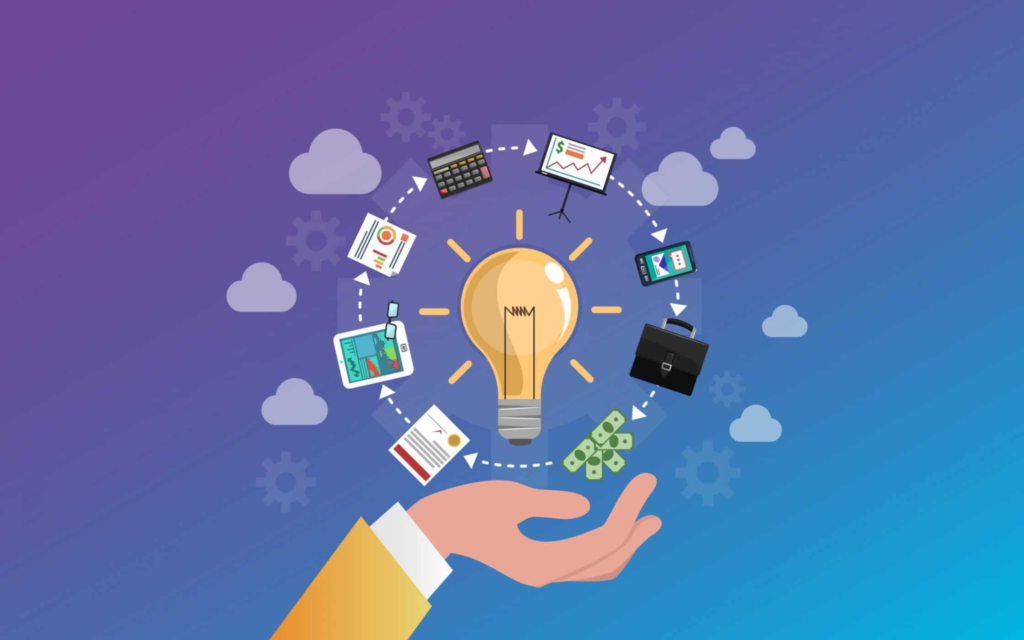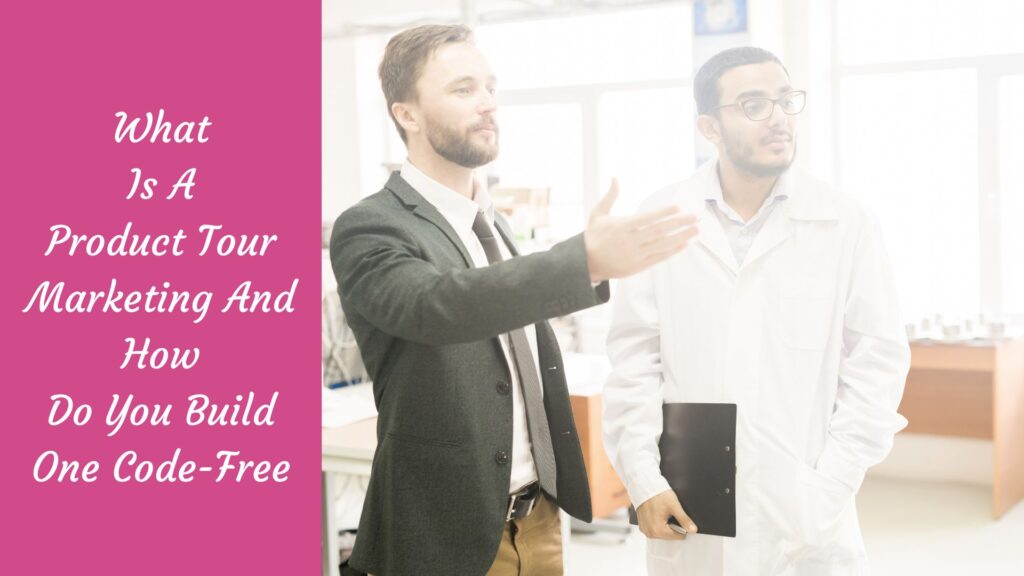Ever felt overwhelmed when trying to learn about a new product? You’re not alone.
Figuring out a new app or website can be confusing and time-consuming.
But what if there was a simpler way to get to know a product?
That’s where a product tour comes in handy! In this blog, we’re going to show you what product tour marketing is and how you can create one without any coding.
Say goodbye to the frustration of learning new products and hello to quick, easy understanding.
Understanding Product tour marketing

What is Product Tour Marketing?
Product tour marketing is like giving your product a chance to make a grand entrance at a party where everyone’s eager to meet it. It’s the process of creating an interactive walkthrough that showcases the key features and benefits of your product. This strategy helps users get acquainted with your product in a fun, engaging way, significantly better than just tossing them an instruction manual and saying, “Good luck!”
- Explanation and Purpose
Think of it as a friendly guide taking new users by the hand and showing them around their new digital home. By breaking down the functionalities into easy-to-digest steps, it demystifies the product, making it more accessible and less intimidating. Sites like UserGuiding offer great tools to create these engaging walkthroughs without needing a single line of code.
Why Product Tour Marketing is Essential for SaaS and Tech Companies
Boosting User Engagement:
New users are like party guests who decide within the first few minutes whether they’re going to stick around. A compelling product tour can turn their initial curiosity into deep engagement by showing them how your product fits into their life or business. This interaction can be the difference between a user bouncing or sticking around to become a loyal customer.
Reducing Customer Churn Rate:
It’s frustrating to sign up for a new service, only to feel lost about what to do next. This frustration often leads to high churn rates. A thoughtful product tour addresses this by ensuring users know how to get the most out of your product from the get-go, thereby keeping them around for longer.
Enhancing User Experience:
A smooth start sets the tone for the entire user experience. By providing users with a guided introduction, you’re not just telling them you care about their experience; you’re showing it. Enhancing user experience from day one can lead to better reviews, more referrals, and ultimately, a stronger brand.
Examples:
- Slack‘s interactive tour breaks down its multitude of features into digestible pieces, making it easier for new users to understand how to use the platform effectively.
- Airbnb offers a seamless onboarding process that guides hosts through listing their space, highlighting key features and tips, which enhances user satisfaction.
Incorporating product tours into your marketing strategy isn’t just about showing off your product; it’s about building a bridge between what you offer and your users’ needs. By tailoring this experience, you lay down the foundation for a lasting relationship with your users.
The Evolution of Product tour marketing

From using clunky manuals to sleek, automated guides, the evolution of product tour marketing has been dramatic. Here’s a quick breakdown:
- From Manual Demonstrations to Automated Guides: A Brief History
Gone are the days of thumbing through dense user manuals. Today, companies leverage technology to provide interactive, automated guides that users can follow at their own pace. For example, the transition from physical manuals to Zendesk’s interactive product tours showcases how simplicity reigns supreme in modern user onboarding.
- The Role of AI and Machine Learning: Personalization of User Experience
AI and machine learning have revolutionized product tours, making them not just guides, but smart companions. These technologies analyze user behavior to tailor experiences specifically for the user’s needs. Take Netflix as an example. This streaming giant uses AI to recommend shows and movies, creating a personalized viewing experience that keeps subscribers coming back for more.
- Trends in Product Tour Marketing
The latest trends in product tour marketing aim to make user onboarding as seamless and engaging as possible:
- Voice-guided Tours: Voice instructions add a personal touch, guiding users like a friend would. The GPS app Waze uses voice-guided navigation to help users reach their destination effortlessly, showcasing how effective this method can be.
- Interactive Walkthroughs: Gone are passive tutorials; users now expect to learn by doing. SaaS platforms like HubSpot use interactive walkthroughs to engage users dynamically, boosting retention and satisfaction.
- Integration with Analytics Tools: Understanding user interaction with product tours is critical. By integrating with analytics tools, companies can measure engagement and improve user experience. Google Analytics is a popular choice among businesses looking to track these metrics and enhance their product tours.
Key Components of an Effective Product tour marketing

- Intuitive Design
- Simplicity and Clarity: Your tour should be as clear as the sky on a sunny day. Consider how Dropbox makes using their service as straightforward as storing files in a folder on your desktop. No muss, no fuss.
- Visual Appeal: A good look catches the eye, and a great design keeps it. Apple‘s website, for example, is a master class in design that’s both stunning and easy to follow.
- Targeted Content
- Identifying User Personas: Think about who’s on the receiving end. Spotify does a bang-up job creating playlists and recommendations that feel personally crafted for each listener.
- Crafting Relevant Messages: Your message should fit like a glove. Tailor it like Evernote — they make it crystal clear how their app can help you remember everything from everyday to-dos to major project plans.
- Interactive Elements
- Quizzes and Polls: Engage your users like BuzzFeed does with their entertaining quizzes. It keeps the interaction fun and personalized.
- Call-to-action (CTA) Buttons: Guide users on what to do next. A “Sign Up” CTA from Netflix not only stands out but also tells you precisely where to click to start your binge-watching adventure.
Incorporating these elements will not only amp up your product tour but also ensure it’s geared towards success. Keep things simple, personal, and engaging, and watch your users stick around for the long haul.
Building a Code-Free Product tour marketing

Step-by-Step Guide to Creating Your First Product tour marketing
Alright, let’s break it down into bite-sized pieces to make building a code-free product tour as easy as pie. We’re talking about using tools that don’t require you to know any programming, kinda like constructing a LEGO set without needing to be an engineer. This way, anyone can craft an engaging and informative product tour. Ready? Here we go:
Leveraging No-code Platforms
First up, no-code platforms are your best friends here. They’re like those easy-to-use apps where all the complicated stuff is handled behind the scenes. Think of them as the WYSIWYG (What You See Is What You Get) editors of product tours.
- Examples of Popular No-code Tools for Product Tours:
- Appcues: Great for creating those slick, interactive guides without writing a line of code.
- Userpilot: Another top contender that lets you customize your tours to match your branding perfectly.
- Intercom: More than just chat software, Intercom offers product tours that are easy to set up and highly effective.
- Comparing Features and Pricing:
Before you choose, think about what you need. Appcues is fantastic for its straightforward interface, while Userpilot gives you a bit more customization power. Intercom, on the other hand, is a powerhouse if you’re also looking for customer support tools. Price-wise, they all offer different plans, so pick what fits your budget and needs. Always keep an eye out for free trials to test the waters.
Step-by-Step Guide to Creating Your First Product tour marketing
Step 1: Planning Your Product tour marketing
- Defining Objectives: Know what you want to achieve with your tour. Increase sales? Educate users? Having clear goals is like having GPS coordinates for your trip.
- Mapping the User Journey: Imagine your user’s path through your product. It’s a bit like planning the itinerary for a road trip, making sure you hit all the interesting spots.
Step 2: Designing the tour marketing
- Selecting the Right Template: Choose a layout that feels like home for your content. It’s like picking the right outfit for an occasion – you want to look your best.
- Customizing Visuals and Text: Make it yours. Customize with your brand colors and voice, so it’s like walking into your digital living room.
Step 3: Integrating Interactive Elements
- Adding Quizzes, Surveys, and CTAs: Keep it interesting with quizzes, get feedback through surveys, and guide with clear CTAs (Call-to-Actions). It’s about making the experience engaging, like having a good conversation.
Step 4: Testing and Feedback
- Conducting User Tests: Get some folks to take your tour and watch how they interact. Think of it like a dress rehearsal before the big show.
- Gathering and Implementing Feedback: Listen to the feedback and tweak accordingly. It’s like fine-tuning your playlist based on what your party guests are digging.
Step 5: Launch and Analyze
- Deploying Your Product Tour: It’s showtime! Launch your tour and welcome users.
- Monitoring Engagement Metrics and Adjusting Accordingly: Keep an eye on how users are interacting with your tour. Use tools like Google Analytics to track their moves. If something’s not hitting the mark, tweak it. Think of it like optimizing your route on Waze in real time to avoid traffic jams.
And there you have it, a straightforward, no-stress guide to creating a product tour that doesn’t need you to be a coding guru. Keep it simple, make it engaging, and always be ready to adapt based on what works best for your audience.
Best Practices for Product Tour Marketing
When it comes to nailing your product tour marketing, think of it as serving up your favorite quick snack — it needs to be easy to digest and leave your audience wanting more. Here’s how to keep it crispy and fresh:
1. Keeping It Short and Sweet
Nobody likes a long-winded lecture. Keep your product tours as concise as a catchy TikTok video.
- Balancing Information and Length: It’s all about giving just the right amount of info without overwhelming your audience. Think of Goldilocks — not too much, not too little, just right. Check out how Dropbox does it by highlighting their features with brief descriptions and engaging visuals.
2. Continuous Improvement
Your product tour isn’t a “set it and forget it” kind of deal. It’s more like your favorite smartphone app that’s always rolling out updates.
- Utilizing Analytics for Iteration: Use tools like Mixpanel to see how users interact with your tour. Find out where they drop off or what they click on the most, and use that intel to make your tour even better.
3. Seamless Integration
Your product tour should feel like an integral part of your website or app, not a tacky add-on.
- Ensuring Compatibility Across Platforms: Whether your users are on their sleek new iPhone or a trusty old laptop, your product tour should work flawlessly. BrowserStack is a pro tool for testing your tours across different devices and browsers to make sure everyone gets the VIP experience.
By incorporating these best practices, you’re not just creating a product tour; you’re crafting a user experience that’s as smooth as scrolling through your favorite Instagram feed. Keep it concise, keep improving, and make sure it plays nice with all devices. That’s the secret sauce to a product tour that turns browsers into buyers.
Case Studies: Successful Product Tours
When it comes to creating an unforgettable product tour, the proof is in the pudding. Here, we’ll walk through a couple of examples that have set the standard for how it’s done.
Tech Giants and Startups Alike
Example 1: A Breakthrough SaaS Platform – Slack
Slack, the popular communication tool for teams, mastered the art of the product tour by focusing on simplicity and usability. Their tour guides new users through essential features with clean, easy-to-follow visuals and instructions. What stands out is how Slack manages to highlight its robust capabilities while keeping the user’s learning curve in mind.
Example 2: An Innovative Mobile App – Duolingo
Duolingo takes the cake for a mobile app that cleverly uses product tours. By gamifying the learning experience, they introduce users to their language-learning app with interactive lessons that start the moment you sign up. Their use of friendly mascots and immediate feedback hooks users right from the start, demonstrating the app’s value within minutes.
Lessons Learned
Reflecting on these examples, several key strategies emerge:
- Focus on User Experience: Both Slack and Duolingo prioritize a seamless transition into using their platforms. This strategy reduces frustration and encourages exploration.
- Show, Don’t Tell: Utilizing visuals and interactive elements proves much more effective than blocks of text. Users can quickly grasp concepts and see the value of the product firsthand.
- Immediate Value: Introduce users to your product’s core value or a “wow” moment early in the tour. This instant gratification keeps interest high and encourages deeper engagement.
- Personalization and Gamification: Duolingo’s approach of making learning personalized and fun can be a huge draw. Consider ways to make your product tour engaging and unique to the user.
- Keep It Updated: Both platforms continuously evolve, and so do their tours. Updating your tour with new features and feedback ensures it stays relevant and effective.
Key Takeaways from Each Case Study
From our exploration into successful product tours, it’s clear that the balance of information, engagement, and ease of use is crucial. Here’s what can be drawn from Slack and Duolingo:
- Making the complex simple is an art. Breaking down your product into digestible pieces can significantly enhance user adoption.
- Engagement is key. Interactive elements can turn a basic tour into an unforgettable experience.
- Don’t make users wait to see value. Showcase your product’s magic early in the tour to captivate your audience from the get-go.
By incorporating these insights, your product tour can become not just a feature of your platform, but a compelling story that draws users in and makes them want to stay.
Future of Product Tour Marketing
Emerging Technologies
The future of product tours is as bright and innovative as a Silicon Valley startup’s pitch deck. With technologies like Augmented Reality (AR) and Virtual Reality (VR) stepping into the limelight, the way we experience product tours is bound for a revolution.
- Augmented Reality (AR) allows users to see a product or feature in their own space before making a decision. Ikea’s Place app is a prime example, letting you visualize how furniture fits in your room.
- Virtual Reality (VR), on the other hand, transports users into a completely immersive environment. Take Oculus Quest’s virtual showroom, where you can explore products in 3D, giving a whole new meaning to “try before you buy.”
The Importance of Personalization
Personalization isn’t just a buzzword; it’s the future of engaging product tours. AI-driven customization tailors the user experience based on individual preferences, behavior, and data.
- Companies like Netflix and Spotify have set the pace, using AI to recommend movies or playlists. Imagine a product tour that learns what features you’re interested in, guiding you through a bespoke experience as personalized as your Spotify Discover Weekly playlist.
Predictions for the Next Decade
Looking ahead, here’s where product tours are headed:
- Interactive and Immersive: Expect product tours that are more than just a series of clicks. Interactive elements, gamification, and immersive environments will make learning about a product as engaging as playing a video game.
- User-Controlled Learning Pace: Users want to explore at their own pace. Future product tours might include options to deep-dive into features or skip ahead to what interests them most, ensuring a user-centric experience.
- Integration of AR/VR for a Try-Before-You-Buy Experience: AR and VR will elevate the product tour from a simple walk-through to an interactive experience, where users can “use” features virtually.
- Enhanced Personalization Through AI: Expect smart product tours that adapt in real-time, offering personalized paths based on user actions and feedback.
Where Product Tours Are Headed
In essence, the next decade of product tours is shaping up to be an era of personalized, immersive experiences. With advancements in AR, VR, and AI, users will enjoy tours that are not only informative but also engaging and tailored to their needs. The future is about breaking the fourth wall of digital screens, creating a connection between users and products like never before.
FAQs
1. What makes product tour marketing stand out in today’s digital marketing landscape?
Product tour marketing uniquely engages users by providing interactive and immersive experiences directly within the product itself. Unlike traditional marketing, it allows users to understand the product’s value proposition and features through a hands-on approach. This method has gained traction for its effectiveness in enhancing user understanding, retention, and overall satisfaction without leaving the digital product environment.
2. Can I create an engaging product tour without any coding skills? How?
Yes, creating a code-free product tour is entirely possible thanks to no-code platforms designed specifically for this purpose. Tools like Intercom, Appcues, and WalkMe allow you to design, customize, and implement product tours directly into your application or website through a user-friendly interface. These platforms offer drag-and-drop functionalities, template libraries, and real-time preview options, enabling anyone, regardless of their technical background, to build immersive product tours.
3. How do AI and machine learning enhance product tour marketing?
AI and machine learning technologies significantly boost the personalization and effectiveness of product tours. By analyzing user behavior, preferences, and feedback, these technologies can tailor the product tour experience to meet each user’s specific needs and interests. For instance, they can suggest the most relevant features to explore based on user role or previous interactions, making the product tour more engaging and beneficial for the user.
4. What are the latest trends in product tour marketing that businesses should be aware of?
One of the most notable trends is the integration of voice-guided tours and augmented reality (AR) elements, which offer a more interactive and immersive experience. Additionally, leveraging analytics to refine and personalize tours based on user engagement data is becoming increasingly common. There’s also a growing emphasis on creating mobile-responsive tours, recognizing the significant portion of users accessing products via mobile devices.
5. What common mistakes should I avoid when creating a product tour?
A few key mistakes to avoid include making the tour too lengthy or complex, which can overwhelm users; failing to highlight the product’s value proposition clearly; neglecting to test the tour across different devices and platforms; and not collecting or acting on user feedback to improve the tour. Ensuring your product tour is concise, informative, and optimized for all users will help you avoid these pitfalls and create a more effective marketing tool.
Conclusion
In conclusion, effective product tours embody a blend of engagement, personalization, and innovative technology to foster user adoption and satisfaction.
Through examples like Slack and Duolingo, we’ve seen the power of seamless user experience, immediacy of value, and the potential of AR, VR, and AI to revolutionize future product tours.
As we stride into a future where user experience is king, the lessons learned here serve as a blueprint for creating product tours that not only inform but also inspire. For those eager to further explore the evolving landscape of product tours, we invite you to LEARN MORE.

